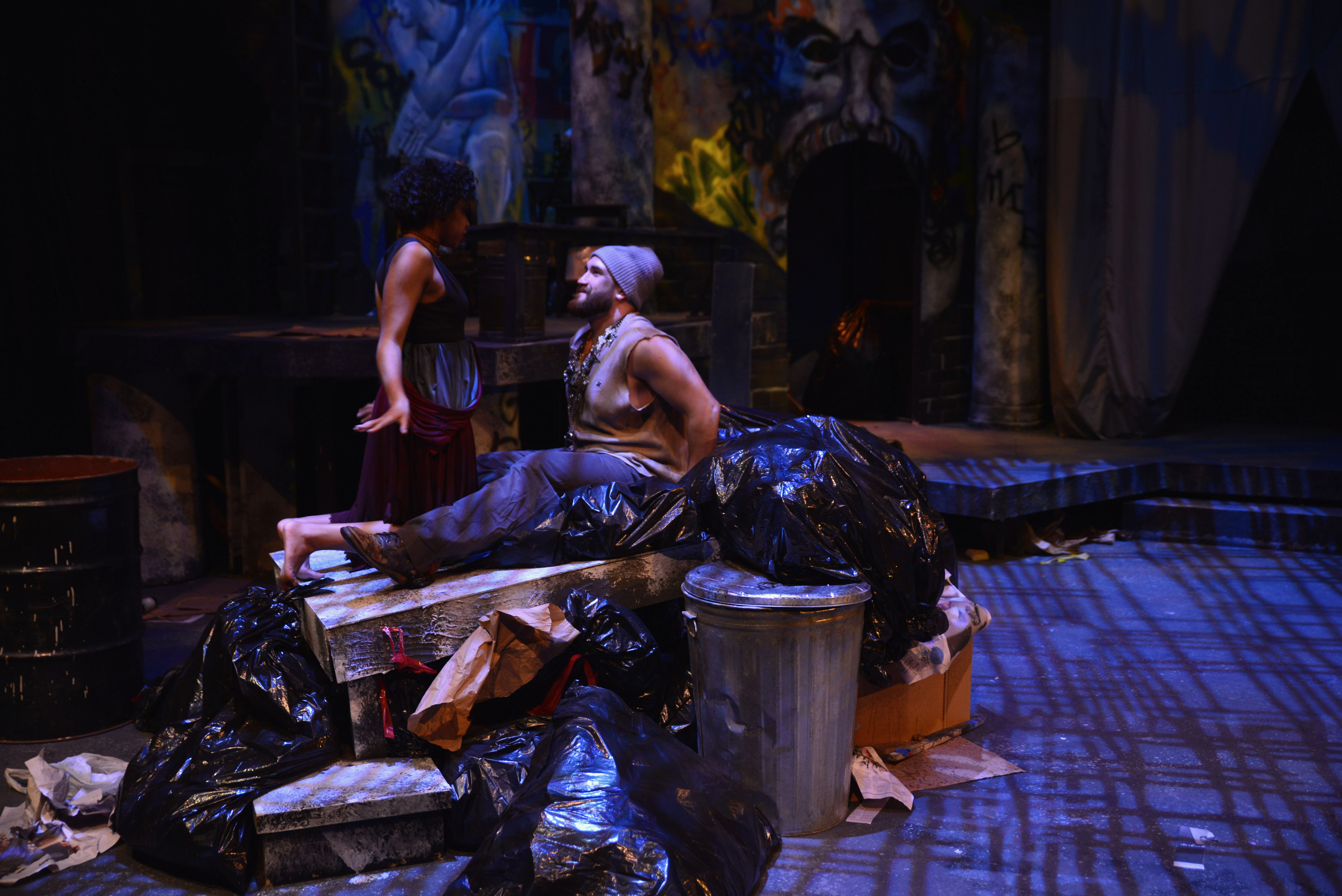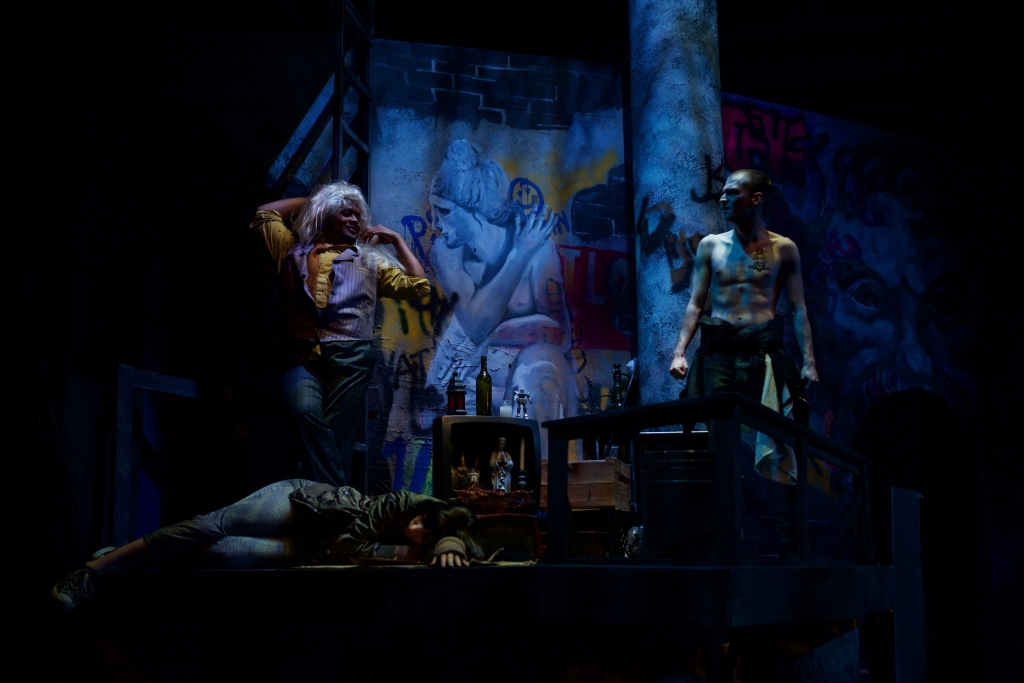
“Polaroid Stories” combines myth and truth to tell stories of homeless youth
By: Taylor DeVille, Associate Arts & Life Editor
What do you get when you combine Greek mythology with drug abuse and homeless teen anguish? Some pretty dark stuff.
Last weekend, audience members journeyed to “the edge of the underworld” during “Polaroid Stories,” directed by David White. Written by Naomi Iizuka in 1997 after interviewing runaway teenagers in Minneapolis, the show presents vignettes in a nonlinear fashion to tell the stories of various characters, whose names you might recognize from Greek myths—Persephone (Dani Liggens), a cocaine addict; Narcissus (Liam Watkins), a gay prostitute and Echo (Tanya Orellana Arguedas), his ever-present companion; and D (Aaron Hancock), short for Dionysus, the “creator of chaos in the underworld,” Hancock said.
In White’s adaptation, this underworld takes on the appearance of a chamber somewhere dark and deep, like a sewer, complete with piles of garbage, graffiti, tunnels and hidden passageways. A chain link fence separates it from the world of the living. Combined with creepy ambient sound, scenic designer Bridget Lindsay and sound designers Jay Herzog and White easily draw in the audience and allow them to be absorbed into this dark, gritty world.
The small cast of 10 had only five weeks of rehearsing fast-paced dialogue and character-building before opening night. In what senior acting major Liggens described as a “collaborative effort,” the cast researched their roles and were given autonomy to develop their characters.
“[White] was the captain of the ship, if we’re using that analogy, but he allowed us to point to where it’s going,” senior acting major Hancock said.
Although the show is adapted in part from Ovid’s “Metamorphoses,” it’s not necessary for the viewer to be familiar with the text. Without some background knowledge on Greek mythology, however, the audience is likely to quickly get lost in the mythos of the show.
“It was definitely not like anything I’ve seen before,” freshman pre-EMF major Marissa Davies said. “I love Greek mythology. There were some [stories] I knew, some I didn’t, so now I want to look them up and read more.”
Being a completely character-driven show without one singular protagonist, White worked with the actors to help them create individual character arcs.
“[White] had a lot of input with [the show], but he let us take it and grow with it,” Liggens said. “He did have a vision, […] but it was really up to us to create the world.”

The world they created was, as one might guess, not a very happy one—except for D, perhaps, the mirthful and magnetic drug-dealer who delights in seducing lost souls like Oklahoma Boy (Matthew Iannone) with drugs.
Iannone’s performance as the speed-addicted Oklahoma Boy (known in other adaptations as “Skinhead Boy”) stands out amidst some of the cast’s wooden acting. His mania is almost infectious, his desperation and emptiness palpable.
“It was this really intense shot through peoples’ lives,” sophomore art major Jacob Watkins said. “[It was] an intense blur seeing the rise and fall of all these people trying to live life, and it all just unraveling in front of them. I thought it was really interesting.”
In perhaps the most compelling story arc of the show, the audience watches as Orpheus (Jake Zeranko) tries to break through the fence to rescue the woman he loves, Eurydice (Michelle Payton).
As the myth goes, Orpheus was a divinely talented musician who attempts to rescue his wife Eurydice from the underworld. By playing his beautiful, mournful music, Orpheus softens the hearts of Hades and Persephone, who allow Eurydice to follow Orpheus to the upper world so she may live again, the condition being that Orpheus does not look back at her until they reach earth.
Orpheus, of course, glances back at Eurydice as he crosses the threshold to the upper world. She disappears forever.
Payton delivers powerful monologues as Eurydice, who, after crossing “the river of forgetting” into the underworld, is haunted by the voice of her abusive partner, although she does not remember him. Zeranko also plays Tereus, a mythological king (and the son of Ares) who rapes and mutilates his wife’s sister, Philomel (Michaela Howell). Tereus and Orpheus seem to be almost fused in “Polaroid Stories.”
Although Iizuka sought to illuminate audiences on the turbulent lives of the homeless kids she interviewed, “Polaroid Stories” doesn’t do much to inspire empathy for them—by combining the stories she heard (some true, some not) with Greek mythos in a series of erratic, non-linear scenes, the audience has to really work to connect with, and feel for, the characters.
Even so, it’s difficult to not find yourself falling into a kind of nihilistic depression while watching the “thieves, perverts and junkies” of the underworld, as Oklahoma Boy puts it. Overall, the performances from the cast worked well to create a richly dark world that enveloped the viewer. For some audience members (like myself), the urge to dissect the characters and their motivations isn’t easily suppressed.
But with “Polaroid Stories,” that approach isn’t going to work.
“Don’t try to analyze every little thing,” Liggens said. “Just embrace the characters and live with [them] in their world.”
“Polaroid Stories” runs Tuesday through Thursday at 7:30 p.m. in Center for the Arts. Tickets can be purchased online or at the box office.

